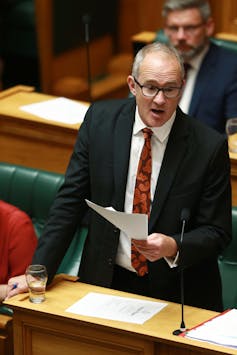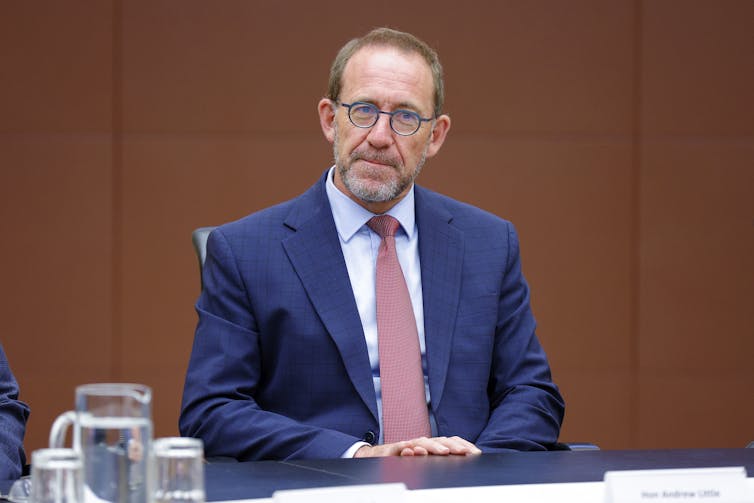Defence Minister Andrew Little’s recent announcement that New Zealand would be “willing to explore” participation in military technology sharing – or “pillar two” – under the AUKUS security arrangement has already divided opinion.
Proponents have argued participation will enhance New Zealand’s security and help deter China in an increasingly contested geopolitical environment. Critics have suggested it would compromise New Zealand’s antinuclear commitment, undermine diplomacy and raise the prospect of a destabilising arms race in the Pacific region.
But missing from the debate so far is any clear analysis of how participation in pillar two of AUKUS might infringe on New Zealand’s policy approach to autonomous weapons systems (AWS).
That’s because of lack of clarity about two things: what kinds of technology sharing and development would be included under pillar two, and just what New Zealand’s policy position on AWS currently is.
What do we know about pillar two?
When AUKUS was announced, the promise to equip Australia with nuclear-powered submarines naturally dominated headlines. The other focus of the partnership, however, is cooperation on “advanced capabilities”.
While little detail has been released publicly, these capabilities include a range of high-tech applications: undersea robotics and autonomous systems, quantum technologies, AI and autonomy, advanced cyber technologies, hypersonic and counter-hypersonic capabilities, electronic warfare, defence innovation and information sharing.
Read more: Approach with caution: why NZ should be wary of buying into the AUKUS security pact
In some ways, pillar two of AUKUS is more significant than pillar one. It is certainly more imminent than the submarine delivery. It may also be “of greater long-term value and more strategically challenging”, according to analysis by the Australian Strategic Policy Institute.
There are a lot of uncertainties with emerging technologies, with no way to predict how they will develop or be adopted for military purposes. They also have more wide-reaching societal and economic implications, since much of the research and development capacity sits in civilian industries and universities.
AUKUS and autonomous systems
Ultimately, of course, AUKUS is about competing militarily with China. It’s the “most consequential strategic competitor” of the US and its allies and partners, according to US Assistant Secretary of Defense Mara Karlin.
Pillar two cooperation, Karlin argues, is necessary to accelerate military innovation, enhance interoperability and integrate the “defence industrial base” across partner countries in response to the threat posed by China.
Read more: As Australia signs up for nuclear subs, NZ faces hard decisions over the AUKUS alliance
Last month, it was revealed Australia, the US and the UK had held a trial of AUKUS advanced capabilities, focused on AI and autonomy. According to the UK Ministry of Defence, the event succeeded in achieving several “world firsts”, including AI-enabled assets from the three countries successfully operating as a “swarm”.
The systems were “testing target identification capabilities”, indicating the likely lethal applications of some pillar two technologies.
Where does NZ stand now?

While some clarity is beginning to emerge on the technologies being explored under pillar two, New Zealand’s policy approach to these types of technologies has become increasingly murky.
Following advocacy by the former minister for disarmament and arms control, Phil Twyford, cabinet committed to supporting international regulations and bans on AWS in late 2021.
When Twyford announced the policy, he declared the emergence of lethal AWS would be “abhorrent and inconsistent with New Zealand’s interests and values”, and would have “significant implications for global peace and security”.
Yet the cabinet paper itself contained significant caveats. These were aimed at allowing for maintenance of interoperability with key defence partners, and ensuring the New Zealand tech sector could continue to pursue “the responsible development and use of AI”.
Twyford’s leadership on this policy position is important given the loss of his ministerial role following Chris Hipkins’ first cabinet reshuffle as prime minister. Whether the approach outlined in the 2021 cabinet paper survives his demotion is not yet clear.
Thus far, his successor in the disarmament and arms control role, Nanaia Mahuta, has made no statements on AWS policy.

Interests and values
Given these developments, Andrew Little’s openness to considering pillar two cooperation under AUKUS takes on an interesting complexion and raises numerous questions.
Some have suggested the defence minister has moderated his original comments on openness to pillar two, perhaps having faced some pushback from the prime minister and foreign minister.
Most recently, Little has emphasised the uncertainty around what New Zealand could offer under pillar two. But he has maintained there was an interest in collaboration on cybersecurity, quantum computing and artificial intelligence.
The recent tests of military AI technologies by the AUKUS partners, and the associated comments on their likely military purposes, point to the likelihood of various combinations of lethal and autonomous capabilities emerging from pillar two cooperation.
Before making any commitment to engaging in this part of the AUKUS arrangement, New Zealand’s political leaders need to carefully consider if these technologies are in keeping with the “interests and values” behind Phil Twyford’s initial push toward banning or regulating AWS.
Jeremy Moses receives funding from Royal Society of New Zealand Marsden Fund.
Sian Troath receives funding from The Royal Society of New Zealand Marsden Fund.
This article was originally published on The Conversation. Read the original article.







